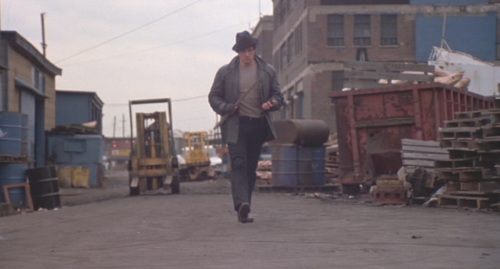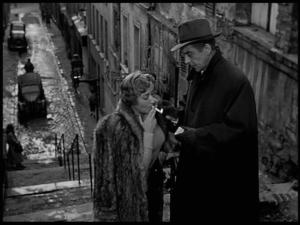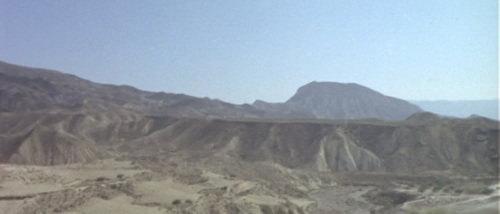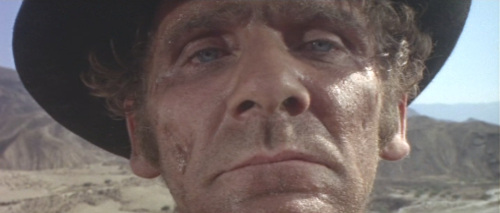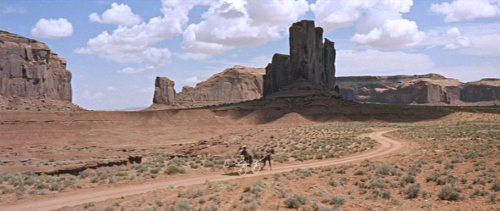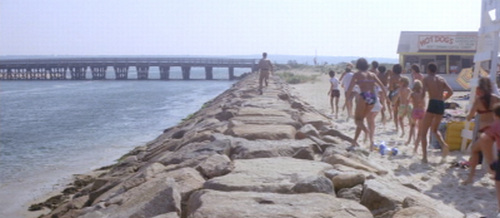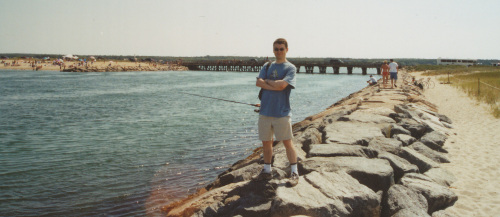I still don’t see enough discussion of the importance of location in film. It’s not that it doesn’t get discussed at all; I’ve seen a fair few academic books and articles over the years that touch on it, and the recent upsurge of interest in the depiction of cities in film (which leads to books like Celluloid Skyline and Screening the City and The Cinematic City) reflects a fairly closely related interest. But I’ve felt for a long time now that location is one of the most critical elements in a film; it often seems to me that the places and locations we see in films deserve much more primacy in discussion about movies.
When I think about my favourite movies, one thing that strikes me is how many of them create a vivid sense of place; I love films that make me feel like I’ve visited somewhere. That isn’t just for obvious epic style movies in exotic locales, like a Lawrence of Arabia; I’m thinking about movies in all sorts of genres, and all sorts of types of locations. So it might be the L.A. suburbs of E.T., or the New England town of Jaws, or Woody Allen’s idealised New York in Manhattan, or the frontier backwoods of McCabe and Mrs Miller, or even the fantasy environments of the original Star Wars. One of the key things that separates these films from their less successful imitators is the sense of immersion in those places that they offer.
I suppose I’m temperamentally inclined to fixate on place: I work as an urban planner, so I take some of that preoccupation with how we’re affected by our physical surroundings into the cinema with me. But I think there’s also something fundamental at work here too. I’m hardly alone in observing that films are often about escapism: not just in the shallow Hollywood sense, but in the sense that movies of all kinds seek to take us out of our current state-of-mind and immerse us in their own particular world. When this kind of psychic transportation is successful, the sense of having visited a place can be palpable. That feeling, for me, is a sure sign that a film has worked well.
One of the tricky things about discussing this idea of place in movies is that it’s hard to separate two different ideas: the role of location as an element in the filmmakers’ toolkit, and location as an aesthetic result of the filmmaking process.
What I mean by the former point is that location becomes one of the ingredients available to filmmakers, like casting, musical score, cinematography, editing, and the framing and composition of shots. Traditionally, the setting of a film is just one of many ingredients lumped under the vague and broad term mise-en-scene, but I would argue it needs to be pulled out of that catch-all term and given more attention as a discrete consideration. An attentive filmmaker will think about the way location informs character, mood, style, and theme. When Rocky walks through the run-down streets of Philadelphia in the early part of the first movie in the series, the director communicates lots of things: we learn things about Rocky by observing both his background and mindset, and at the same time, we feel a general sense of melancholy because of the ugliness of the urban locations. That grittiness, in turn, helps place the film within a more realist mode of filmmaking than earlier genre pictures, and the groundwork is being laid for the film’s theme that great things can be achieved by people from the seemingly most unlikely locations. Character, mood, style, theme. So location becomes a big part of the directors’ toolkit. Indeed, in some cases location is a key to a genre: the western, film noir and road movie genres, for example, are defined largely by their particular types of locations.
So location is an ingredient in filmmaking, but it can also be an output of the other ingredients of cinema. That “strong sense of location” I covet in a movie isn’t just a result of choosing an appropriate setting for the movie (although that will be part of it). Most other aspects of a film inform the locations presence in the final film. For example, a widescreen format can give an expansive, epic view of locations as in Lawrence of Arabia, whereas a narrower format might give a more intimate feel. The blocking of shots, placement of cameras, camera movement, composition of the frame, and editing patterns all effect the way in which the audience understands the film’s geography. As very rough rule, longer, steadier, and more generously framed shots give the audience more chance to take in the environment: think of the long, contemplative shots of rural Texas in No Country for Old Men. At the same time, though, limitation of our views of a setting can shape how it is perceived, as when a fairly nondescript woods and empty house are made threatening through limitation of our views of them in The Blair Witch Project. Cinematography and lighting can be crucial to defining location: think of the crisp but moody black-and-white Paris of Rififi, or the hazy, nostalgic look of the old west in McCabe and Mrs Miller. Casting plays a part: the town in Jaws feels more real because various locals are pressed into service in supporting roles, and the New York of Mean Streets and Taxi Driver is defined in part by the company of actors Scorsese uses. Production design and special effects can create rich but essentially fictional environments, as in Metropolis or Blade Runner. Even aural cues, especially music, can be crucial: think of the way Gershwin’s “Rhapsody in Blue” defines Woody Allen’s Manhattan, or Mark Knopfler’s score the Scotland of Local Hero, or Ennio Morricone’s music the mythic frontier of Once Upon a Time in the West. In all these examples, location becomes an output of the combination other cinematic devices.
Longtime readers – should I have any – might have noticed me touch on these kind of issues before, and I don’t claim some unique sensitivity to the issue. But it is an interesting issue to bring to the foreground, rather than simply noting in passing as most writers on film (including myself) traditionally have; I’m just embarking on a university research project that will be looking a lot at these kinds of issues, so I expect it will be a little more front-and-centre on this page in coming months. For now, I’ll just allude to some of the different angles we can take on locations, beyond the “location as input” and “location as output” schematic I’ve just outlined.
Faces as Location
I mention above the way characters can help define a place in a movie, but for a really pure, extreme example, what about simple, unadorned use of faces as landscape? I’m thinking of the famous opening shot of The Good, the Bad & the Ugly where we have a long shot of a desert environment, only to have an actor’s head suddenly intrude, turning the extreme long shot into an extreme close-up. Thinking about this in terms of our sense of location, the relatively generic landscape shot doesn’t tell us much: it’s not even clearly a western location. The face, however, does a great deal to plant us clearly within Leone’s universe. There’s the cowboy hat, for a start, but more important is how grubby and dishevelled the actor is. These pieces of information taken together immediately reshape the landscape from one that is not even unmistakeably western, to one that is distinctly of Leone’s west.
Location as Homage
The Leone reference brings up the idea of location as reference or homage to previous filmmakers. The most famous example is Monument Valley, in Utah, which became inextricably linked to the works of John Ford, notably through its use in Stagecoach and The Searchers. Sergio Leone made a point of traveling to America specifically to film a handful of shots in the valley for Once Upon a Time in the West, and since then the location has become such a visual cliche it can really only be used when the purpose is tongue-in-cheek (as in Back to the Future Part III).
Such use of locations in order to inherent accumulated audience goodwill might seem like it would only capture the attention of movie buffs, but think of what a difference continuity of location in a movie series can make. A big reason Jaws 2 seems so much more legitimate a sequel than the subsequent Jaws 3 is because the latter didn’t use the original’s Martha’s Vineyard locations, but the former did. Even when everything else is subpar, as in the second Jaws film, the judicious use of locations can give a cosy familiarity.
Absence of Location
What do we lose when we remove real locations from films? There are all sorts of examples where absence of location can drastically shape a film or even whole movements in cinema. Animated films have to do without real locations, and it’s a loss of fidelity that the medium feels keenly and has to compensate for. Similarly, the technicalities of on-site shooting limited the availability of real locations in both the early silent period, and from the thirties well into the sixties. The stylistic impacts (both positive and negative) of the tendency to shoot films on soundstages in those decades is enormous; similarly various film movements (notably the Italian Neo-realism, the French New Wave, and the New Hollywood of the seventies) made a distinct virtue out of their embrace of real locations.
And now, since the 90s, we have seen the re-emergence of a “locationless” aesthetic, with films shot largely or entirely in front of greenscreens (a la the Star Wars prequels, or Sin City) or even in entirely virtual worlds (The Polar Express, Beowulf). Like many others, I feel that films lose something from this lack of location; there is a dislocation and unreality similar to that found when watching old movies with phony rear projection. These films give an example of the importance of location; consider how much more real than the prequel’s Star Wars universe the world of the Lord of the Rings seems, largely because Peter Jackson generally used augmented real locations rather than wholly fake ones (as Lucas often did). A sense of location is important even in fantasy films; and when a film can lend its invented world a sense of location that approaches that of films set in our world, the effect can be very powerful indeed.
Location as Documentary
As well as film’s role in contriving non-real locations, film also plays a role in documenting the real. As we approach a centenary of cinema, our films become more and more a depository of information about the environments in which they were shot. We can appreciate this most readily with our oldest films, which are now being mined as a visual record of what life was like in the early twentieth century. For example, I’ve written before about John Bengston’s book Silent Echoes, which pores over the films of Buster Keaton to find the real locations where they were shot. Because that was generally in and around Los Angeles, that allows Bengston to catalogue the changes that have occurred to the city. The location shots in Keaton’s films become a fascinating document of a by-gone Los Angeles that you would scarcely believe could have existed visiting it now. Dziga Vertov’s innovative “day in the life” film Man With a Movie Camera is similarly invaluable as a record of Soviet life in the 1920s, despite its often abstract style.
Films as Place-builders
Just as films can preserve for posterity places that no longer exist, they can also influence and change real places. New York – along with other great and much-filmed cities, like Paris and Rome – owes much of its identity to its portrayal in the movies. New York has been the definitive movie metropolis through the twentieth century, and its shifting fortunes as a city have been not only reflected but also shaped by its depiction in the movies. If you go to New York the sensation of being inside a giant movie set is uncanny; our understanding of New York as a place is essentially inseparable from its cultural role in countless movies and TV shows. The scary reality is that we learn a lot about the world around us through movies, and over time this actually becomes a self-reinforcing feedback loop. Films make use of real locations; we then reconstruct those places as imagined locations in our heads; which alters the way that we perceive those real locations; which actually effects the real locations (by making them seem glamorous and attracting more residents, for example); which in turn feeds back into the movies (so New York is used in films because of the iconic status that films themselves helped to build). Nobody can measure the effect of Manhattan and Friends and Seinfeld and their many predecessors on real estate prices in Manhattan, but there can be no doubt that there is a very tangible impact from the way our culture makes us think about the place.
Locations as Tourist Destinations
In New York that “inside-a-movie” feeling comes from the overlaying of countless film depictions, as well as the heightened stimulation provided by such a bustling metropolis. Yet fans also seek out locations because they associate them with individual films. This has most famously been seen with the phenomena of Middle Earth tourism in New Zealand, but Tony Reeves’ classic guide for location stalkers, The Worldwide Guide to Movie Locations, is now up to its third edition, giving some sense of the wider interest in seeking out familiar movie locations. When I was in the US a couple of years ago, Reeves’ book helped me locate the precise locations for various scenes in Jaws, and it truly is uncanny to stand in what had previously been only an imagined environment.
Will Brooker, writing in The Blade Runner Experience about the attempts of Blade Runner fans to visit the real places used as the basis for the future L.A., notes that when you get to a real environment and it doesn’t match the fictional one, it is the real that feels wrong. That was my experience. While I’m not naive about how films are made, and obviously knew that film spaces are pieced together from lots of different locations, I still found that the geography of Amity that Spielberg constructed in Jaws was so persuasive that it was distracting when I stood in the real location and it didn’t match the film version. So, while it was a thrill to stand on the same breakwater down which Brody ran in the fourth of July sequence, it was also a bit unsettling to find that the estuary depicted wasn’t just next to the town’s main beach as it had been in the film.
The point is, though, I sought the locations out. And standing in the main street of Edgartown, Massachussets, it felt uncannily like I was I was in the fictional township of Amity. It felt right, it felt real, but of course the comparison I was drawing was with something that never existed outside of my head. That the fictional version could be so persuasive says a lot about the power of place in the movies.

